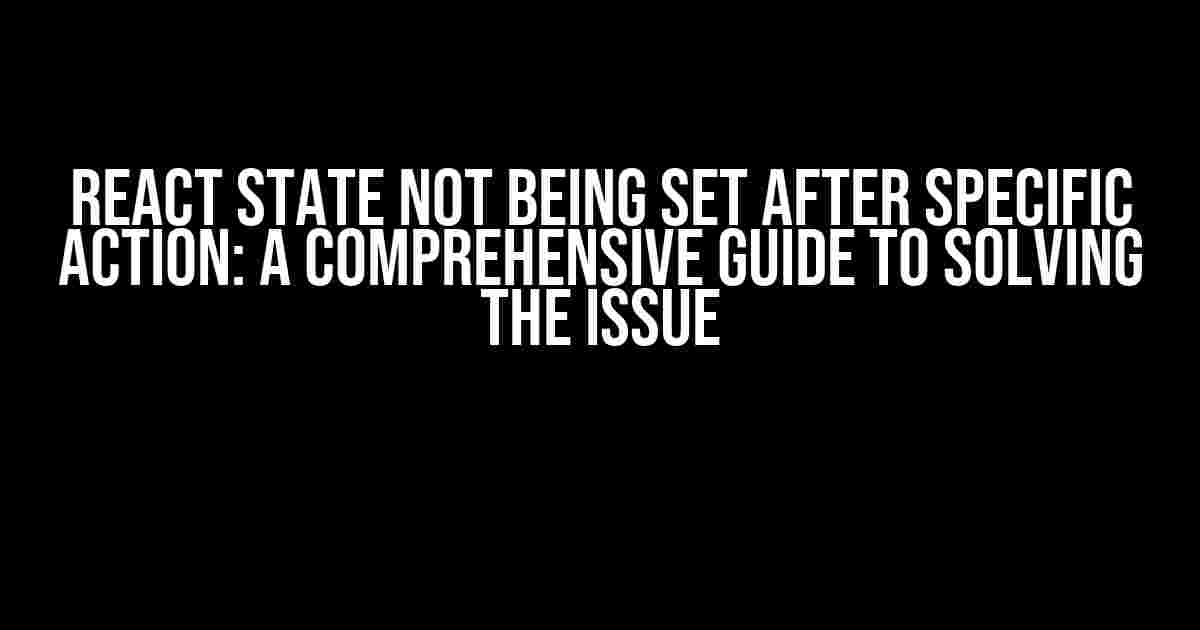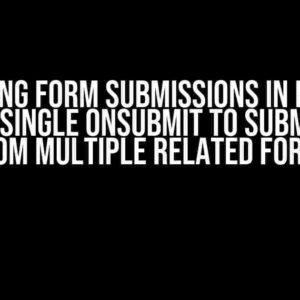Are you tired of dealing with the frustration of React state not being set after a specific action? You’re not alone! This issue can be a real showstopper, but fear not, dear developer, for we’ve got you covered. In this article, we’ll dive deep into the world of React state management, explore common pitfalls, and provide step-by-step solutions to get your state updating like a charm.
What’s Going On? Understanding the Problem
Before we dive into the solutions, let’s take a step back and understand the problem at hand. When you say “React state not being set after a specific action,” it usually means that you’re performing an action, like clicking a button, submitting a form, or fetching data from an API, but the state isn’t being updated accordingly.
There are a few common scenarios where this might happen:
- Using the
this.stateproperty directly - Not using the
setState()method correctly - Using an outdated version of React
- Having side effects or asynchronous code in the wrong places
- Not handling Promises or async/await correctly
Step 1: Verify Your State and Props
Before we start digging deeper, let’s make sure we’re on the same page. Verify that:
- You’re using the correct state property (e.g.,
this.state.myState) - Your props are being passed correctly (if applicable)
- Your state is being initialized correctly in the constructor or with the
useStatehook
import React, { useState } from 'react';
function MyComponent() {
const [myState, setMyState] = useState(null);
// ...
}
Step 2: Check Your setState() Method
The setState() method is the primary way to update state in React. Make sure you’re using it correctly:
- Use the
setState()method to update state, not thethis.stateproperty directly - Pass an object with the updated state properties as an argument
- Use the callback function to ensure the state has been updated before performing subsequent actions
import React, { useState } from 'react';
function MyComponent() {
const [myState, setMyState] = useState(null);
const handleClick = () => {
setMyState({ foo: 'bar' }, () => {
console.log('State updated:', myState);
});
};
}
Step 3: Handle Side Effects and Asynchronous Code
Side effects, such as API calls or database interactions, can cause state updates to be delayed or overlooked. Ensure you’re handling them correctly:
- Use the
useEffecthook to handle side effects and asynchronous code - Use the
useStatehook to update state within the effect - Clean up side effects when the component unmounts to prevent memory leaks
import React, { useState, useEffect } from 'react';
function MyComponent() {
const [myState, setMyState] = useState(null);
const [loading, setLoading] = useState(false);
useEffect(() => {
const fetchData = async () => {
setLoading(true);
const response = await fetch('https://my-api.com/data');
const data = await response.json();
setMyState(data);
setLoading(false);
};
fetchData();
}, []);
return (
{loading ? (
Loading...
) : (
Data: {myState}
)}
);
}
Step 4: Review Your React Version and Dependencies
Make sure you’re running the latest version of React and its dependencies:
Check your package.json file to ensure you’re running the latest version of React:
"dependencies": {
"react": "^17.0.2",
"react-dom": "^17.0.2"
}
If you’re using an outdated version, update to the latest version using:
npm install react@latest react-dom@latest
Step 5: Debug and Inspect Your Code
Debugging is an essential part of the development process. Use the following tools to inspect your code:
- React DevTools: Examine your component’s state and props in real-time
- Console logging: Log state and props to the console to identify issues
- React Debugger: Step through your code and inspect variables
Use the following techniques to debug your code:
console.log('Before setState:', myState);
setMyState({ foo: 'bar' }, () => {
console.log('After setState:', myState);
});
Conclusion
React state not being set after a specific action can be a frustrating issue, but by following these steps, you’ll be well on your way to resolving the problem. Remember to:
- Verify your state and props
- Use the
setState()method correctly - Handle side effects and asynchronous code
- Review your React version and dependencies
- Debug and inspect your code
By following these guidelines, you’ll be able to identify and fix the root cause of the issue, and your React state will be updating like a charm!
| Step | Description |
|---|---|
| 1 | Verify state and props |
| 2 | Check setState() method |
| 3 | Handle side effects and asynchronous code |
| 4 | Review React version and dependencies |
| 5 | Debug and inspect code |
Don’t let React state issues hold you back! With these steps, you’ll be well on your way to becoming a React state master.
Here are 5 Questions and Answers about “React state not being set after specific action” with a creative voice and tone:
Frequently Asked Question
Stuck in a React state rut? Don’t worry, we’ve got the answers to get your state up and running in no time!
Why isn’t my state updating after making an API call?
This is a classic gotcha! Make sure you’re not making the API call in a async function and then trying to update the state synchronously. Try using `async/await` or `.then()` to ensure the state is updated after the API call is complete.
I’m using `useState` but my state is still not updating! What’s going on?
Double-check that you’re not accidentally reusing the same state object or function. `useState` uses a closure to keep track of the state, so if you’re reusing the same function, the state won’t update. Try creating a new state object or function each time you need to update the state.
I’m using a library like Redux or MobX, but my state is still not updating. What do I do?
Ooooh, this one can be tricky! Make sure you’re not accidentally creating a new instance of the store or observable each time you need to update the state. Also, check that you’re using the correct actions or methods to update the state. If you’re still stuck, try debugging the library’s internal state to see what’s going on.
Why isn’t my state updating when I’m using a callback function?
Ah-ha! This one’s a classic! Make sure you’re not accidentally creating a new scope for the callback function, which can cause the state to not update. Try using an arrow function or binding the callback function to the correct `this` context.
I’ve checked everything, but my state is still not updating. What now?
Don’t panic! Take a deep breath and try debugging your code step-by-step. Use the React Dev Tools or the browser’s built-in debugger to see what’s happening when you try to update the state. Sometimes, it takes a fresh pair of eyes (or a good ol’ debugger) to spot the issue.
I hope this helps!


